Businesses use email marketing tools all the time to keep their customers informed and engaged. However, email marketing tools are not just for businesses. Individual eCommerce store owners and even bloggers can use email marketing tools to reach out to a larger audience base.
Bloggers should not think that only regularly publishing content on their website will keep traffic flowing in and keep the business alive. They need to get regular readers to subscribe and keep them coming back to the blog. If you are a blogger, this 'goal' of getting repeat visits and decreasing the chances of users going dormant, can be achieved by smartly using email marketing to your advantage .
There are a number of tools that you can pick from if you are thinking seriously about investing in email marketing. However, in this post, we will discuss two of the most popular options - ConvertKit and MailChimp. I've reviewed these two tools in depth, for you to be able to make a pick quickly. Let's read through.
ConvertKit - A Complete Review of One of the Best Email Marketing Tools for Bloggers
ConvertKit is the first drip email marketing tool that comes to mind for those bloggers who take their blogging business pretty seriously. This is a 'pro's' tool. Nevertheless, it has a simple and handy interface. What stands out about ConvertKit is their customer support and knowledge repository that can be accessed by anyone who needs help with email marketing, at all times.
ConvertKit Features
The features that ConvertKit offers for email marketing are very well thought off. From growing your audience, to understand who your users are and what they like/dislike, to get users to subscribe, ConvertKit's smart users let you do all this and more:

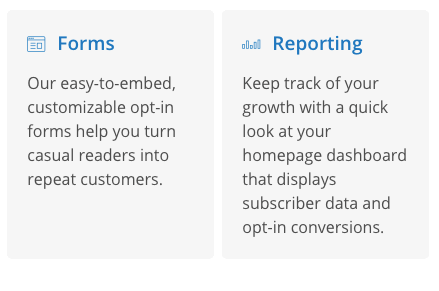

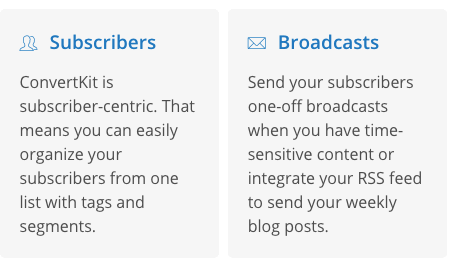
ConvertKit Landing Pages
The whole point of using an email marketing tool for your blog is to be able to get the right audience to subscribe, engage, re-engage, and buy. You need your users' email addresses to send them content in their email boxes and to keep targeting them with timely, relevant content. With ConvertKit, you can get these addresses with pop-ups, forms, etc. And then, this tool also allows you to create landing pages in a jiffy.
Creating a landing page using ConvertKit is a straightforward process. Click on the 'Forms' page on the homepage. Pick the option using which you want to gather leads - a) form b) landing page. In this case, you'll have to select option B. Next, select a style from the template options that ConvertKit offers. There are four basic template style options that can be customized and edited as per your requirement.

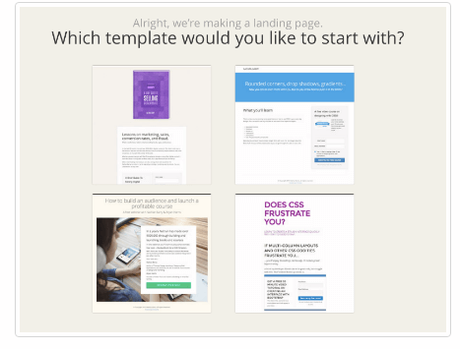
In ConvertKit, you can efficiently manage landing page settings. What this means is that you have the option to save your landing page with a specific name and display your landing page in a way you like.

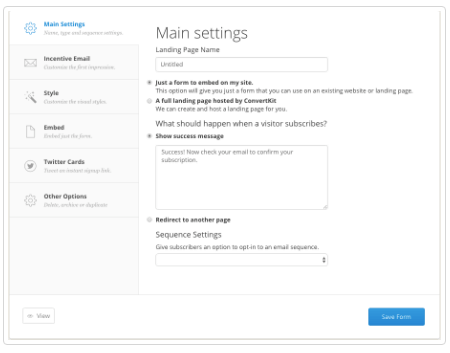
For example, you can either publish the landing page as an individual page or choose to display it as a form on your current website. Landing page settings also allow you to embed Twitter cards on your landing page, edit inline success messages, or redirect subscribers to thank you page. Make sure you save the settings that you make. All the options that you can explore in the Landing Page Setting options have been explained here in this link .

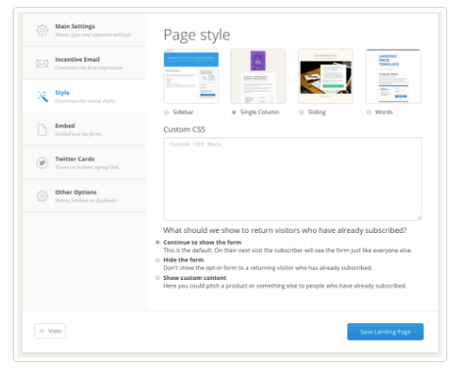
This feature wouldn't have been of much use, or you could say that it would be incomplete without reporting capabilities. ConvertKit allows you to track the number of visitors who made it to your landing page, how many of those visitors became subscribers, and the conversion rate. The section that allows you to view your subscriber report also allows you to see traffic sources from where users landed up on the landing page.
ConvertKit for Professional Bloggers
Now here is something that every blogger must understand - there is a difference between those who just blog and those who consider blogging as a profession. The latter is the set of people who don't just write but earn real money from it. They are successfully able to understand who their audience is, what their potential reader base prefers reading, and how to get them interested enough in subscribing.
For ConvertKit, the ultimate goal for professional bloggers, which is increasing subscriptions, matters. It is one tool that knows how to make things easy for professional bloggers who want to attract a large audience of readers and keep it growing. Now, the thing that makes ConvertKit the best tool for bloggers is that it has been created by bloggers for bloggers. That's how ConvertKit understands all the pain points and all the plus points of those in the blogging business and addresses them so well. Some ConvertKit features that make life much simpler for professional bloggers are:
- Lead Magnet Opt-ins: This works like a double opt-in for users. So, as soon as a user downloads a lead magnet, they will become a part of your list.
- WordPress Integration: Most bloggers - those who have just started out and those who are quite popular professionals, use WordPress as their content management system. The good news is that ConvertKit integrates easily with WordPress. Simply embed the code on any area of the site or use their plugin to integrate with your WordPress blog.
- Resend Unopened Emails: Not everyone opens an email at the time they receive it. Some people even miss out an email sent for the first time. ConvertKit tracks opens and unopens. It then re-sends unopened emails after a specific duration to make sure that users don't miss out on any communication.
My vote is undoubtedly for ConvertKit when it comes to selecting an email marketing tool for bloggers. Apart from being extremely user-friendly and easy to work with the tool, ConvertKit as a company is focused entirely on helping bloggers with enormous reading material to learn from. To put in a nutshell, ConvertKit is the smartest choice who is looking for a tool to monetize their list.
ConvertKit Automation
As promised, I'll be delving deeper into this ConvertKit feature. The reason - email marketing is a pretty ordinary deal without sensible automation. And, being built by bloggers for bloggers, the ConvertKit team understands automation quite well.
The first thing that they understand about bloggers is that they need a tool that makes automation look like a simple task. Therefore, they created what is known as a visual automation builder. ConvertKit with their automation feature ensures that when a subscriber joins their email list, they are sent a series of well-timed, relevant emails to convert them into long-term subscribers/loyal customers.
Key Benefits of ConvertKit Automation
ConvertKit Pricing
To most of us, pricing is a critical deciding factor when it comes to finalizing a product, such as an email marketing tool. That's how it is with investment in SaaS tools as well. You will not buy something that is priced too heavily for your requirements. Let's see if ConvertKit is a good fit for your budget.
The good thing about their pricing is that it is based on the number of subscribers that your blog has. They bill you either monthly or annually based on your preference. All their plans are priced pretty decently, and it doesn't feel like a big blow to your budget. Also, for each plan (other than the one that is for a subscriber list of more than 5000) you get a 14-day free trial. Beyond 5000 subscribers you will need to opt for their 'bigger list' plan, the pricing of which depends on what their calculator estimates. You could also opt for a free demo before signing up for the 'bigger list' plan. Check out all their pricing options here.
ConvertKit Integration
There is no dearth of integrations that ConvertKit offers. From Zapier to Wix to WP Engine, Demio, LeadsBridge, Teachable, Shopify, OptinMonster, LeadPages, GetSiteControl, ClickFunnels, Gumroad List goal to Wishlist, you name the tool and ConvertKit seems to work well with the platform. Most of these tools that ConvertKit integrates with are very useful for bloggers. Depending on which tool your integration requirement you can use the search feature and get all options filtered.
MailChimp as an Email Marketing Automation Tool
MailChimp is a popular alternative to ConvertKit for those who are thinking about investing in an email marketing tool. In fact, MailChimp is the first name that strikes anyone who is considering email marketing seriously. And that's not without reason. MailChimp's branding has been class apart and therefore extremely successful in creating a high recall rate. Everyone knows MailChimp! But, is it the best email marketing automation tool for all businesses?


MailChimp Introduction: For bloggers or for eCommerce businesses?
While I won't say that if you are a blogger, you can't opt for MailChimp, I'd definitely say that it is a better option if you are in the eCommerce business instead.
Even MailChimp focuses its website on the benefits that it offers to eCommerce stores. Its feature page is on point for eCommerce merchants and how they can sell more stuff using MailChimp. The tool provides powerful automation for online sellers, about which we shall discuss in detail in another section. It also helps streamline your marketing efforts and help run ads on social media platforms to gain a wider reach.
Creating landing pages with MailChimp is easy as pie. As an eCommerce merchant, the look and feel of your landing pages matters. Your landing page design can attract or repel users. MailChimp offers you templates to pick from. The plus point is that there is a clear call-to-action for users to move from the landing page to a path closer to converting.
Giving a brand appeal to emails is also something that MailChimp takes care of. Designing need not require you to have any coding knowledge. You can use their drag-and-drop editor to customize your email templates as per your brand's requirement.
MailChimp's email marketing analytics feature is a boon. You can access the advanced reporting feature from any device and keep track of your website conversions. Having an idea about how your campaigns are performing help you figure out the flaws and optimize for improved performance.
MailChimp Pricing
MailChimp's pricing is uncomplicated, and that is another reason why it is so popular amongst people from all walks of online businesses. What's even better is that they don't seem like a splurge. All their plans are intelligently priced. They offer a Forever Free plan too! However, this plan is for only those businesses that have 2000 contacts or less. And, you can't send more than 12000 emails per month if you are opting for this plan. Their plans for growing businesses are priced starting at $10 per month. The pro plan is priced starting at $199/month. Check out their pricing details and the features offered in each plan here.
MailChimp Automation for eCommerce websites
There are a number of email marketing use cases for eCommerce merchants who are planning to invest in MailChimp. For example, using their marketing automation, eCommerce store owners can build segments and apply custom rules to send out trigger-based emails. They could use this function to send out free gifts to the new subscriber list spreading some love and joy to the new set of customers.
As an eCommerce merchant, you can also send out retargeting emails to dormant users who haven't added anything to their cart for the past few months. Or, you could send reminder emails to those users who have added products to cart but not checked out.

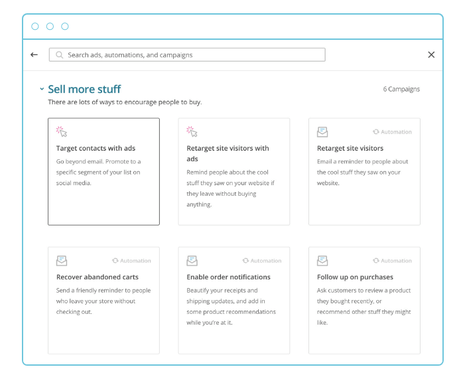
Another reason why eCommerce website owners love MailChimp is that emails created using MailChimp are beautiful irrespective of the device that the user opens them on. Also, emails can be created on MailChimp's mobile app too! Which means ease and convenience for the merchant working with MailChimp. How much more flexible could any tool get?
ConvertKit vs MailChimp
I've compared both these tools in depth, and the only point of comparison between ConvertKit that I'd like to re-emphasize is that both these tools are for different users. While ConvertKit is a great tool for bloggers, MailChimp is the best option for eCommerce merchants. Both these tools are priced in a way that both beginners and professionals can consider to invest in them.
However, there are certain specific features that you might want to read about in detail if you are still confused between the two. For example, while MailChimp offers excellent design flexibility, automation workflows in ConvertKit are unbeatable. Also, MailChimp has advanced functionalities for eCommerce businesses that might not be of any use to a blogger. For example, their email delivery messages such as abandoned cart emails, order notification emails, product recommendation emails, etc.


MailChimp users can also send Direct Mail Postcards, which are personalized printed postcards for your global audience. This is a great branding exercise that they undertake to build better relations with their users to keep them loyal and make them feel special.
Opting for a free trial of both these tools makes sense if you are delving too deep and want absolutely the best for your business.
Conclusion
ConvertKit is the best tool for bloggers when it comes to email marketing; MailChimp is more for eCommerce merchants who need website and user tracking. Both of these email marketing tools are popular amongst their respective user bases. So, if you are looking for an email marketing tool to increase your reach or to improve conversions on your blog or website, consider these two options for sure.
MailChimp focuses a lot on branding; therefore, eCommerce merchants can indeed benefit a lot from using this email marketing tool. ConvertKit focuses on ease of use and making the best of your email list, which is why it is the perfect choice for bloggers. All in all, if you've taken a free trial of both these tools, you'll need no further convincing on why you should look no further. I hope I've been able to review these two tools in the best manner and helped you make a choice. Happy blogging! And, happy selling for eCommerce merchants.
